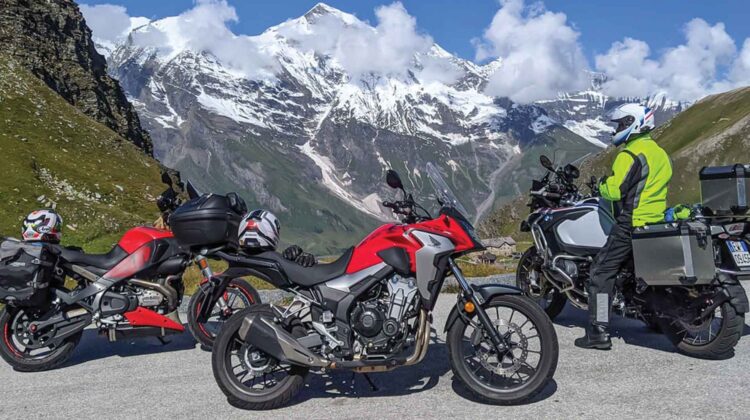
Yes, you’re a good rider. Of course you are. Experienced. Took the safety training course. Ridden all the most challenging roads and rode them well. Deal’s Gap. The Snake. The Rattler. The Back of the Dragon. Done some track days.
Stelvio Pass will destroy you.
Ask me how I know.
If you’re like me, you’ve long dreamed of riding in the Alps. Stelvio is just one of the legendary places. Glossglockner. Furka. Gavia. They’re on every serious motorcyclist’s list of roads to do before they die. Problem is, you might die doing them.
But I had the chance to go to northern Italy and as they say, life is short. Chances like this don’t happen often. Never postpone joy, so I booked my tickets, packed my COVID masks, and reserved a bike in Riva del Garda, Italy.
What made it more feasible is that I had two friends over there who were more than happy to act as tour guides for me. I just needed to get myself there and rent (or as they say over there, hire) a motorcycle, and they’d pave the way, so to speak.
Austin Blessard is an American whom I met more than a decade ago motorcycling around Roanoke, Virginia. I’ve followed his active Facebook presence as he and his new wife have explored by car, bicycle and motorcycle around their new home in Vicenza, between Venice and Verona. Gianni Zanini, who I met from a mutual friend in Blacksburg, Virginia, is from Riva del Garda and lives mainly in the Washington area. He would be in Riva for an extended stay.
Austin had a Buell Ulysses and Gianni had a Ducati Multistrada, V-twins of different stripes.
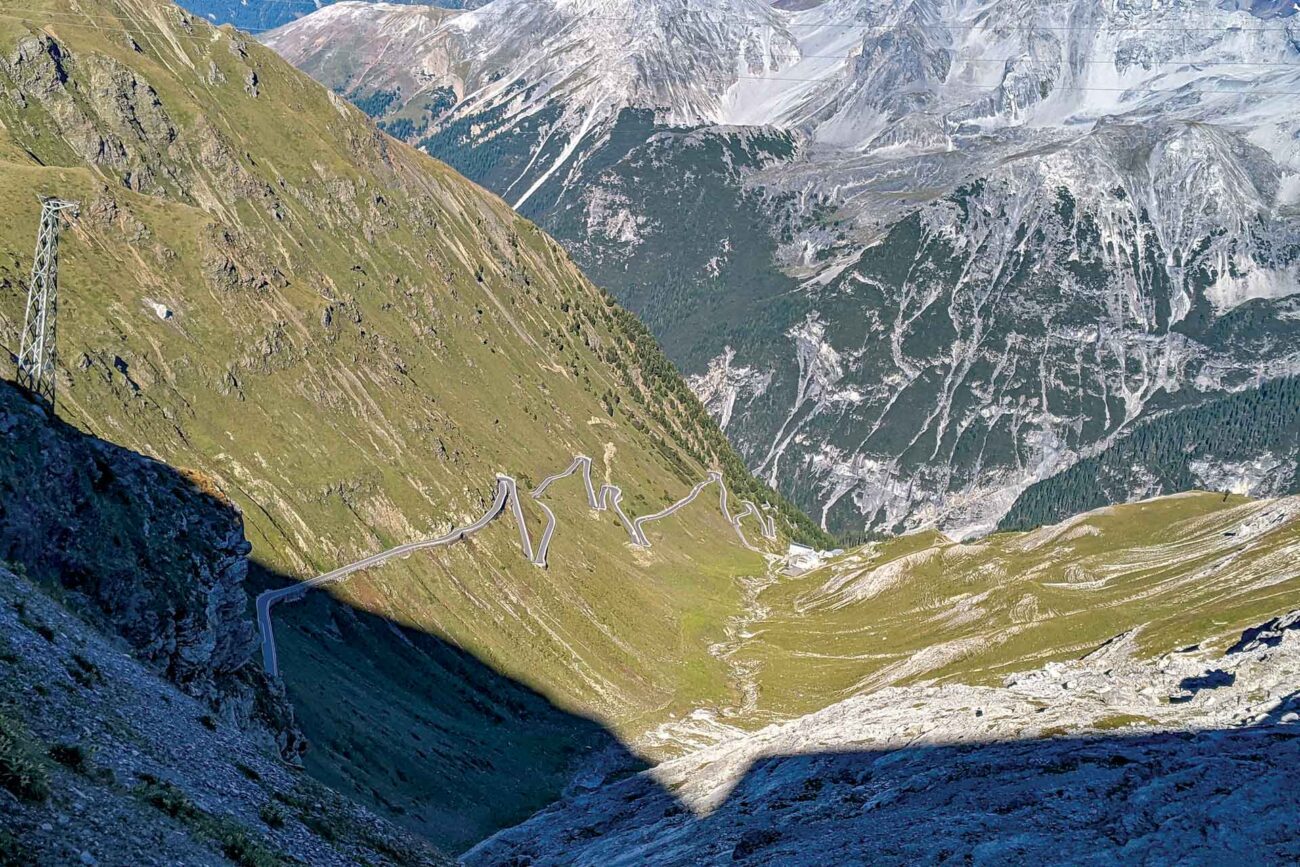
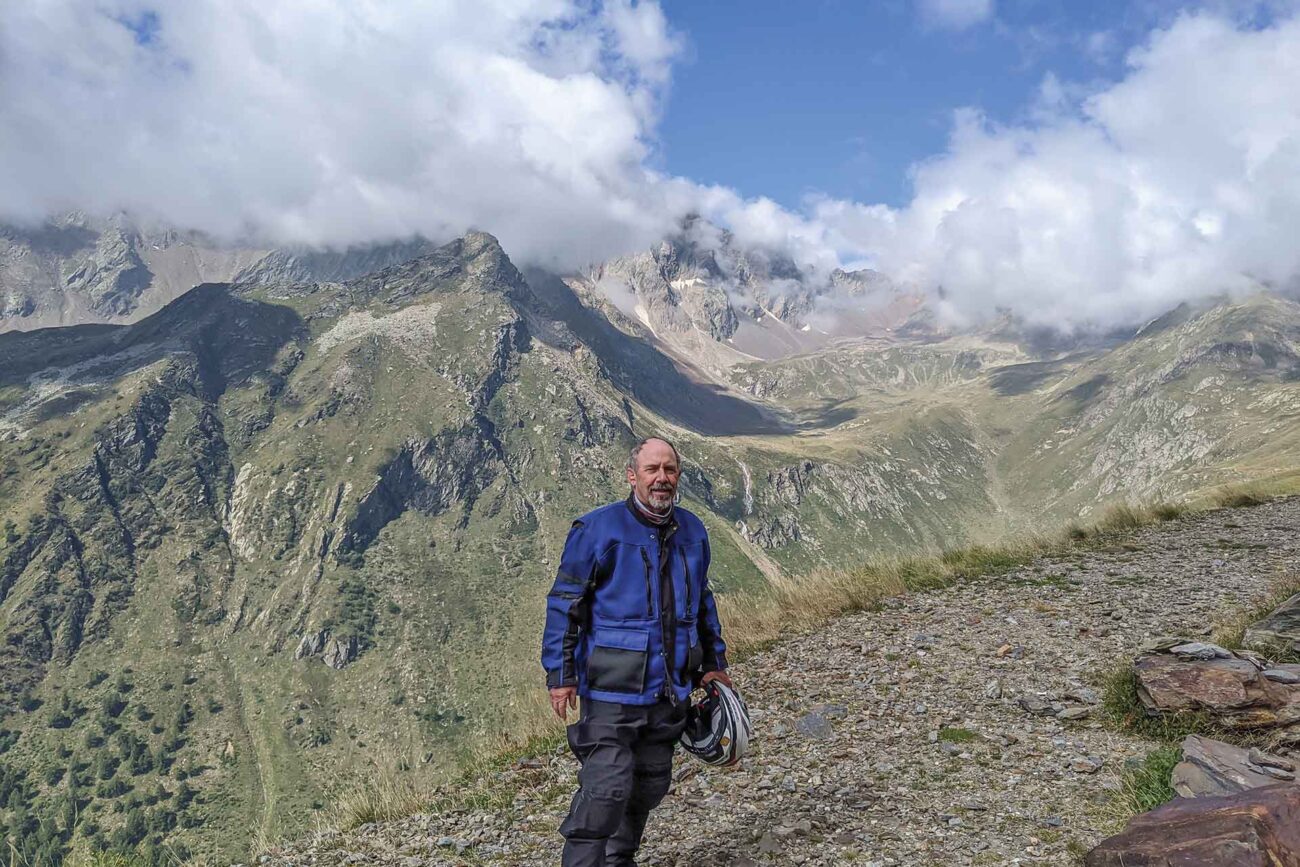
After landing in Milan, my holiday started across the Swiss border on a week-long, strenuous hiking trip around Monte Rosa and the Matterhorn, walking from Switzerland into Italy and back. After a couple of days at lovely Lake Maggiore, I caught the train — why can’t we have decent public transportation in the states? — to Riva, where I picked up my steed for the week, a Honda CB500X.
Soon Gianni, Austin, a friend of his and I were blasting northward toward Stelvio’s approach.
I was already tired from the hours it took to get there, acclimating myself to the brisk pace and trying to find my comfort level with a borrowed helmet, jacket, pants, boots, and of course the new-to-me motorcycle. But no rest for the uninitiated; upwards we went, first through gentle sweepers in the woods, and then into increasingly tighter curves and finally to the iconic hairpins for which it is so famous.
In your mind, it’s just point and shoot. Round the tight corner, gas it up to the next one, decelerate and repeat.
Turns out it’s not that simple.
Readjust your mind to thinking about it as barrel racing, like you’ve seen in the rodeo. Except while horses can turn on a dime, motorcycles can’t. The hairpins, what the Italians call “tornanti,” totally flummoxed me, especially those to the right. They are unbelievably tight and steep.
You swing wide at the entrance, brush the apex, and swing wide on the exit, right? Just like you did at the racetrack. Er, not so fast. As you approach, there’s a car in the oncoming lane, foiling that plan. And when you emerge past the apex, there’s a bus bearing down on you.
On the fifth or sixth turn, that’s what caught me. And I did what muscle memory told me to do: hit the brakes and stop. When I did, the bike fell over to the right, threw me to the ground, and snapped the front brake lever, leaving only a two-finger but usable stub.
Fortunately, I wasn’t hurt, other than my pride, and several passing motorists helped me get myself and the rented Honda upright. But after a few moments rest to gather myself, I still had to get through that curve. And then a couple dozen more tornanti, still to come.
Gianni, who’s been doing this for decades and for whom this iconic pass is child’s play, came back to check on me, whipping his potent Ducati around like a scooter. In his Italian accented English, he commented mock-cheerfully and unhelpfully, “It doesn’t get any easier.”
Somehow, I was able to continue, and I finally reached the pass. From where my challenges began anew on the equally steep downhill side. Which was even steeper.
This was but the first incident of motorcycle parts other than tires and kickstands making contact with the pavement.
The next day, a technician at an independent motorcycle repair shop literally welded a new extension onto the stub, and the little Honda was good as new (although when I returned the bike, the shop insisted I buy a new one).
And on it went.
Over the course of the next several days, we conquered pass after pass, sometimes five or six daily. They start in the tree-clad slopes and heavily touristed valleys. They climb in sinuous curves, like someone threw spaghetti noodles of asphalt against rugged landscapes. As they ascend, the forests give way to grasslands and eventually to just rock. Picture the most rugged scenery in Colorado or the Canadian Rockies and multiply it. The Alps are that grand — go see for yourself if you don’t believe me.
And oh, so stunningly photogenic!
The villages are like scenes from “Heidi” and the mountains are cloud-draped rugged towering spires against azure skies.
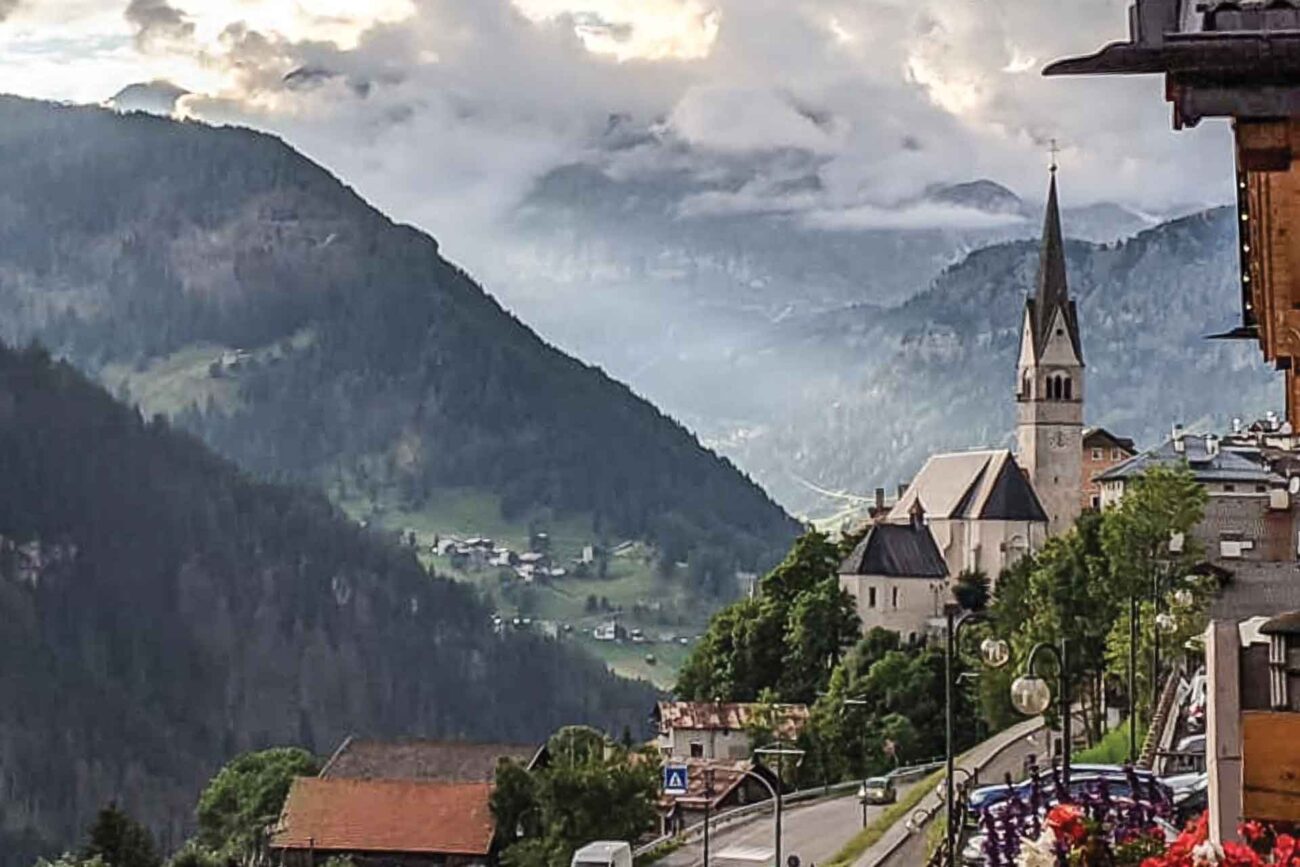
In northeastern Italy, the Italian language gives way to German — the towns carry two names, one each per language. From there we entered Austria, headed to the famous Glossglockner. Its toll road is heavenly and spectacular, mostly well above treeline, and happily not as technical as the Stelvio. I started having real fun!
But everywhere we went, there were scads of people, motorcycling, bicycling, driving, and walking. Summer is short in the Alps and people try to take advantage of the fleeting window of opportunity.
Motorcycling here is generally done at a frenetic, urgent pace. Motorcycles swarm around vehicles like angry bees, passing whenever and wherever. There’s no such thing as “no passing” zones, or if there are, nobody pays any attention.
Yes, there’s oncoming traffic, often lots of it. And there are generally limited sight distances. I saw dozens of motorcyclists pull into the oncoming lane to pass with blind turns only a few dozen meters ahead. Lane-splitting is common, even when there appears to be no room for it.
I imagine orthopedic surgeons do a brisk business in the Alps. I’m told the local newspapers often print stories of injured or killed motorcyclists. Mistakes here are severely punished.
No matter what riding you’re used to anywhere else, it pales in comparison. This simply must be the most difficult, exhilarating, and exciting riding anywhere. Bring you’re “A” game. And still prepare to be humbled.
Someone reportedly saw a rider on a 200 hp sport bike doing a power-slide through a hairpin and carrying a wheelie half-way to the next one. My little Honda, willing as it was, howled eagerly when I pegged the throttle, but lacked the horsepower for such shenanigans. And for what it lacked in power, I more than made up for it in my lack of skill.
Oh, did I mention the road-side drop-offs are often precipitous? Go over the edge on some of them and you’ll starve to death before you hit the ground.
The bikes were generally modern, with only a few vintage bikes to be seen. BMW has a dominant market share. I’m guessing 60% of the bikes. Another 20% are other European brands, such as Italy’s Ducati, Aprilia and Moto Guzzi, and Austria’s KTM. The rest are everything else, like England’s Triumph, Japan’s big four (Honda, Yamaha, Kawasaki and Suzuki) and even some Harley Davidsons and Buell (like Austin’s). There were a surprising number of big Harley style cruisers. How riders muscle them through the tornanti I’ll never know.
These bikes can cost $20,000 to $30,000 and more. And tires, which are $150-250 each, don’t last long. This is a rich (and brave) man’s (and woman’s) sport. Make sure your MasterCard is in good health.
The urge here is to ride like everybody else. But the greater urge is not to die. I constantly reminded myself to exercise restraint and avoid taking chances.
“Michael,” my inner voice would say each morning, “Don’t get yourself killed today. You have people who care about you. Oh, and stupid hurts.”
One thing that made my experience especially vexing was the tallness of the Honda. I’m vertically challenged, and reaching the ground was a literal stretch for me. My own bikes are modified to fit, but this bike was difficult to manage on all but the flattest places, and there’s nothing flat in the Alps. Typically when the going gets dire, stopping is a good idea, but even that was fraught.
The challenges were ongoing. There’s never any rest. Forget about enjoying the scenery, at least while you’re underway. There are lots of vehicles, of both two and four-wheel variety. Bicyclists. All manner of road surfaces from smooth pavement to broken pavement to cobblestones (I’m told nothing will get your attention like wet cobblestones.). Steep grades, up and down. And constantly varying road widths, all narrow by U.S. standards.
We went through a couple of tunnels that would be a tight fit for a minivan. Just one at a time. To make thing worse, at the lower end of two of these tunnels were hairpin, steeply downhill turns to the right, with sight distance not far beyond my dashboard. Imagine heading steeply downhill through a tunnel that felt like if you stretched your arms wide, you could brush both walls, and then seeing a car appear at the bottom. Yikes!
Austin was commendably patient with me and my inadequacies.
“You are riding as I was when I got here three years ago,” he said. “I could do all the Appalachian roads. I did some track days, briskly. But on my first ride up Stelvio, I made every mistake. I almost launched myself over multiple guardrails. I exited corners into the oncoming lane. I had terrible, sloppy inbound and exit lines. It took me three times up and down Stelvio to sort of figure it out. I’m fine now and I don’t hold people up anymore. But it’s not for the timid or faint of heart. It requires an equal dose of boldness and skill.”
Fortunately, I began to build some technique on these turns and got a bit more confident. But just a bit. Coming down the Glassglochker, there was a gaggle of four or five bikes bearing down on my rear-view mirror. I lost no pride when I waved them around me, but only one actually passed me before reaching a sweeping right curve. Two-thirds of the way around, his front wheel lost contact and his $25,000 BMW R1250GS went sliding down the pavement, shooting sparks, while he scuffed up his Cordura suit. My impulse was to stop and assist, but he was quickly upright and had his buddies behind him. And remember, I’m too short just to stop and park the Honda anywhere.
That was pavement incident No. 2.
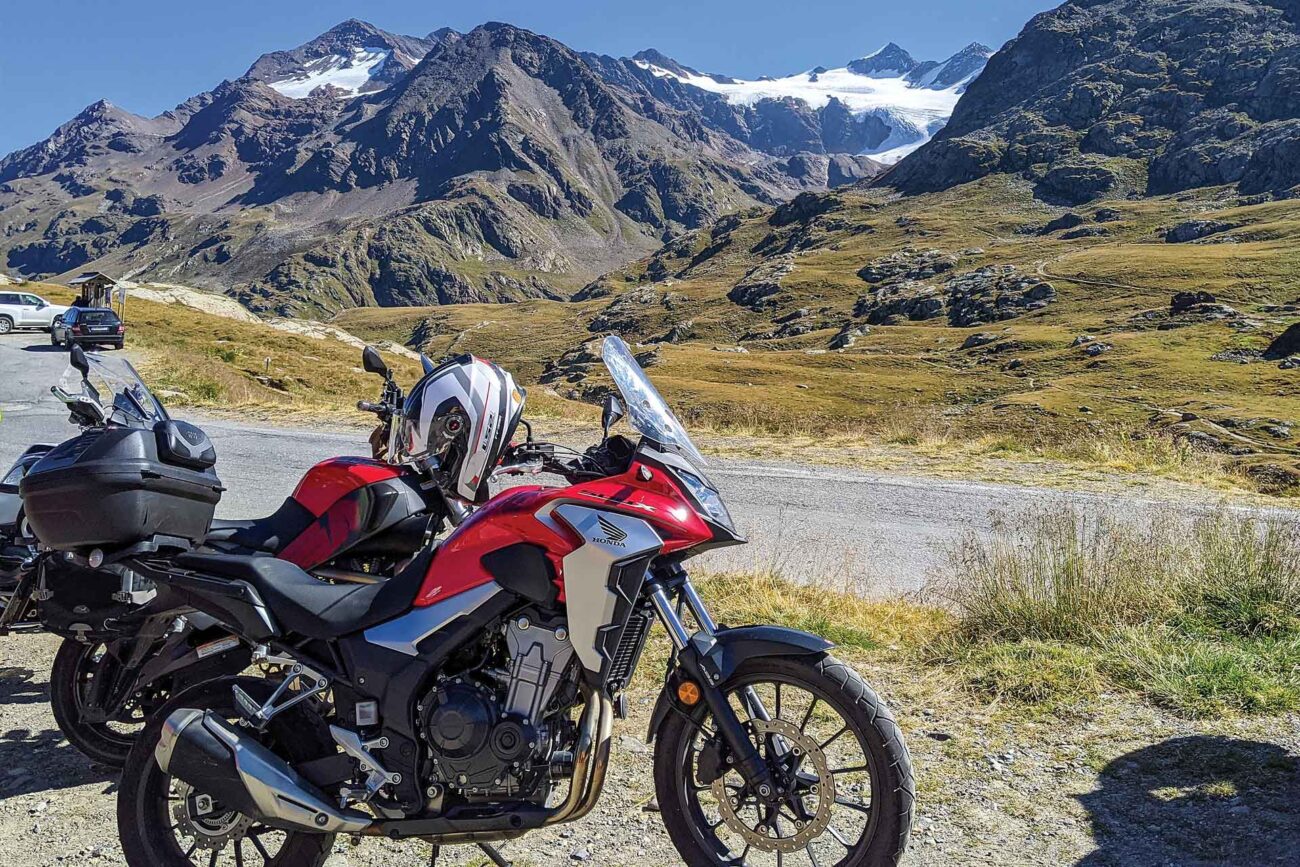
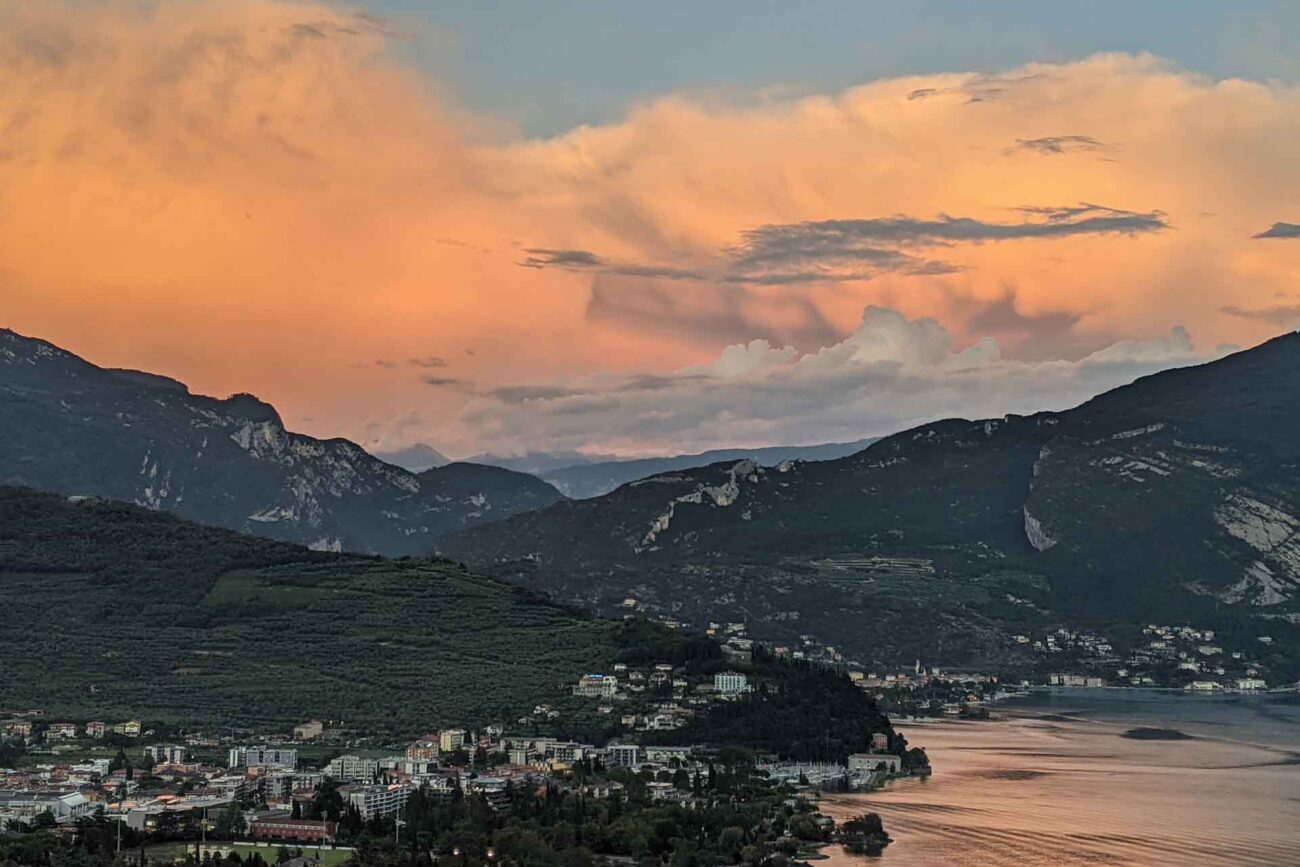
Back at the charming Gasthof Post Austrian hotel in Oberdrauburg, serendipity happened and we were treated to an outdoor community band concert, dressed in Sound-of-Music tracht and playing Oktoberfest marches. Ein Prosit!
On the next day’s ride, as I was coming around another frightful uphill right-hand hairpin, fighting with my bike to make the turn, a bus came bearing down in the oncoming lane. Again, I made a full stop to avoid hitting him head-on. But my sudden stop caused the rider behind me to lose control and fall avoiding me. With the help of several stopped motorists, we hefted his 600-pound motorcycle vertical and got him going again.
Pavement incident No. 3.
After four days of hard riding, my adrenaline meter was pegged and my nerves were shot. And I figured Austin and Gianni were tired of babysitting me, so I took a day off, sent them on their way, and went hiking instead. I took a cable car from the valley into the clouds above and did an out-and-back, stress-free but still strenuous walk of 7 miles.
The next day, we were back at it, strafing more canyon and mountain pass roads. My technique for those dreaded right-turn hairpins began to improve as did my confidence. I was convinced to get off the saddle to the left, push hard on the right grip to throw the bike into a steep lean while keeping my torso upright, and feather the clutch if necessary. I never got comfortable with it or good at it, but at least I didn’t face every turn with trepidation. And I didn’t fall over again.
While the intensity is daunting, the rewards are giddying. Find yourself at the top of Gavia after a successful, rapid run, and your sense of accomplishment is extreme. You look down from the pass at the curvaceous ribbon of roadway and know that you can ride, if not at the speed of the best, at least on the roads of the experts. And the views are sublime. You look down from the top of Stelvio at those hairpins, one after another after another, all 47 of them, and know that you did it. You did it! YES!
Our penultimate hotel was near the Italian town of Arabba, and it was Uber-charming. Wood framing everywhere. Flowers draped from every balcony. Great food — as it was everywhere. And a magnificent view down-valley to a spectacular Dolomitic peak. Breathtaking!
Our last night was spent at a castle. A real castle called Castle Pergine. Built centuries ago. It was 90 minutes from Riva del Garda in the vineyard foothills. Even that last run into Riva was frenetic, following Gianni as he unhesitatingly lane-split and sped his mighty, crimson Multistrada into his old hometown.
So yes, go ride the Alps! But take an advanced skills course before you go, with special emphasis on tighter maneuvering. And buy travel insurance. And get your will updated and your affairs in order.
Michael Abraham is an author and avid motorcyclist in Blacksburg, Virginia. Read more of his adventures at mabrahamauthor.com.


